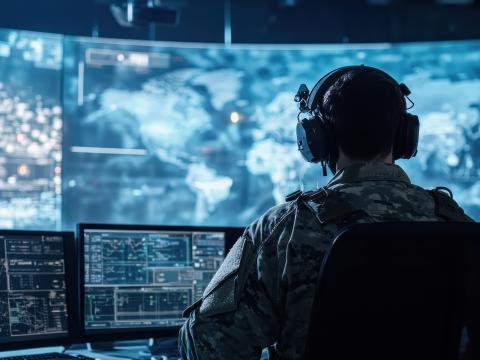Air and Space Force Modeling and Simulation Officials to Industry: Harness Reference Architecture
The U.S. Air Force and U.S. Space Force see the future of modeling and simulation capabilities aiding readiness and continued training improvements, and they expect to harness advanced artificial intelligence (AI), said Rodney Stevens, senior executive service, program executive officer, Air Force Training Directorate, and Col. Corey Klopstein, USSF, program executive officer, Operational Test and Training Infrastructure (OTTI).
Stevens manages a $7.4 billion portfolio of Air Force modeling and simulation assets, with about 1,500 people, while Klopstein leads the new OTTI at the service’s Space Systems Command, Los Angeles Air Force Base, California.
Along with several other service leaders, the two air and space officials spoke during the November 18 National Training and Simulation Association webinar about their upcoming I/ITSEC conference, held December 1-4 in Orlando. At the conference, military leaders will share more specifics about their priorities and desired capabilities from industry.
In advance of that, Stevens highlighted what he would like to see from the modeling and simulation industry. The service is aligning under its new chief of staff, Gen. Kenneth Wilsbach, USAF, who took over last week, Stevens noted.
Wilsbach set readiness as one of his key focus areas, emphasizing that aircraft availability, air crew proficiency and the ability to generate combat power at scale were just not “metrics.”
“Airmen must fly, fix and train with purpose and realism,” Stevens said, relaying Wilsbach’s views. “It resonated with me, that we need to train with purpose and realism to ensure we are ready at any time for our nation's call.”
At present, Stevens is identifying any gaps in their overall synthetic strategy. He also wants to understand what is available from the defense industrial base—especially regarding open architecture.
“My goal is to actively engage with industry and academia to better understand what are the technologies out there,” Stevens noted. “How do we get after the ability to infuse open architectures into the overall simulator environment? How do we get after to being able to synthesize those architectures together in a formal way that allows us to be more effective and efficient, so that pilots in the actual operators can maintain concurrency on the real systems that they're operating with on a day-in and day-out basis?”
Stevens also sees taking “more of an enterprise approach,” common architectures, which will allow the service to be more flexible.
In addition, concurrency is an issue, Stevens noted, one which the service aims to tackle over the next three-to-five years.
“The operational flight profile programs that are on the aircraft and what we actually have in our simulators are not the same,” he stated. “And that's one of the biggest challenges we have, is concurrency. The reasons are that one, we are in a physically constrained environment, and two, the technology is slightly misaligned. As our aircraft operational flight program software is upgraded, our simulators fall behind.”
OTTI, meanwhile, with a $4 billion portfolio, is positioning its efforts to secure the platforms and systems needed for the foundation of the Space Force’s high-end, advanced test, training and tactics development for all Guardians.
“It is an exciting time for the nation’s space test and training enterprises,” Klopstein said. “As we work to advance readiness and resilience in the space domain, we need to drive innovation, strengthen partnerships and prepare our Guardians for the challenges of tomorrow.”
The service’s Space Training and Readiness Command and the newly stood up Combat Forces Command share the critical mission of preparing combat-ready forces for the space domain, the colonel noted.
OTTI and the new System Delta 81 are partnering with those commands to ensure a unity of effort to deliver material solutions for their operational customers, the colonel explained.
“Our vision is to create the immersive arena for achieving space dominance,” Klopstein said.
Their efforts must also reflect the Space Force’s shift in focus preparing for a highly complex adversarial space environment.
“The Space Force is pivoting its focus to combat-ready training for high-intensity environments,” Klopstein said. “Before, the Space Force has prioritized individual proficiency and the mission tasks of space operators, as well as functionality of space systems.”
As such, any modeling and simulation capability must be closely aligned with the operating environment.
“OTTI’s vision is to build systems that allow operators to switch seamlessly between their operational system and their training environment, adding red threat stimuli so that we can sharpen our Guardians’ tactics against the thinking adversaries that we know are out there,” the colonel said. “We are developing that simulation environment, that simulation layer that is going to plug seamlessly into the operational ground infrastructure. That is our goal as we provide that realistic simulation environment to train our Guardians.”
With other Space Force leaders, OTTI is also considering standards for this evolving future of capabilities. “The delivery of future ground systems will require specific instances to support both test and training, [so] it's important for us to develop the appropriate standards so we can plug in blue and red models into those systems and into those simulation environments as we go forward,” Klopstein noted.
In addition, the colonel also offered advice to modeling and simulation companies: use the service’s reference architectures.
“I’d just like to finish with a call to action for industry to continue to partner with us,” he noted. “I want you all to leverage the OTTI government reference architecture products that are out there on SAM.gov. We recently released updated products. Use those as your starting point as you're engaging with us and point to things within those government reference architectures that you know we need. You have capabilities where you can help us fill gaps.”
Lastly, both officials expect to see AI-related capabilities for the synthetic environment, but they warned that they will not pursue AI tools just for the “technological novelty” of having AI tools. They need specific capabilities that will directly improve training, and in result, operations.
“To ensure operational dominance in today's ever-changing environment, the preparation and mastery of complex multidomain operations can only be achieved through advanced modeling and simulation and training systems,” Stevens noted.





Comments